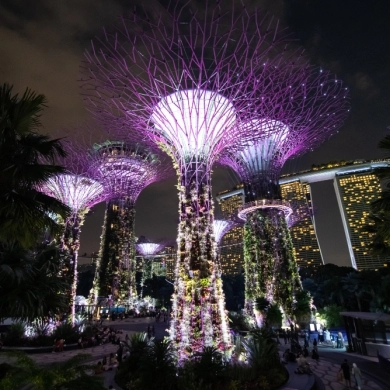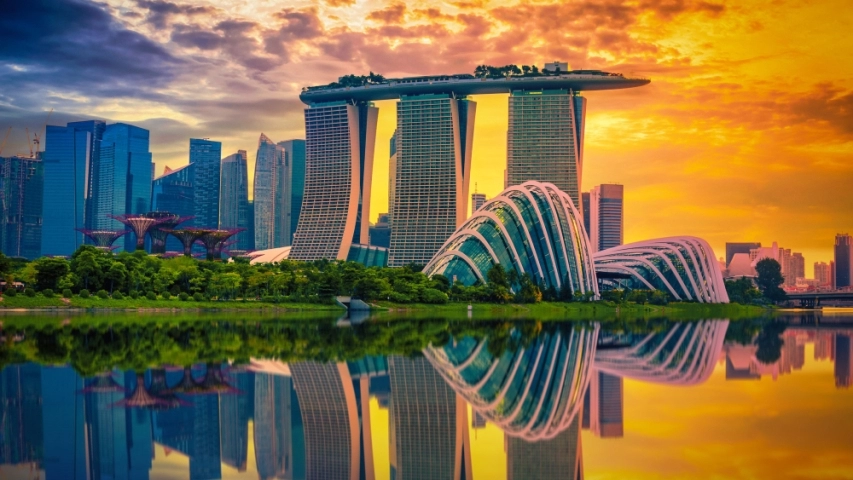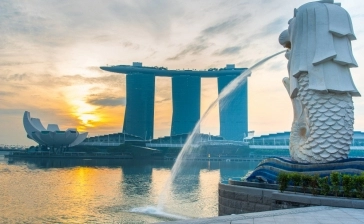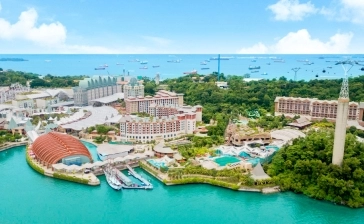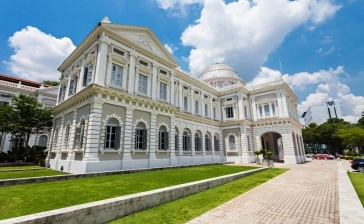Singapore: An Accessible Gem in the Heart of Asia
Glistening like a diamond in Southeast Asia, the small island-city of Singapore masterfully blends its rich historical tapestry with a futuristic flair. Impressively, it stands as an inclusive destination, welcoming visitors with mobility challenges, ensuring barrier-free travel experiences. Established as a British trading post in 1819, Singapore has metamorphosed from a modest port into a buzzing metropolis. Its past can be traced in the Colonial District, adorned with British-era buildings and statues narrating the colonial tale. Despite its bustling atmosphere, the area is wheelchair-friendly, with ramps and paved walkways ensuring effortless movement.
Discussing Singapore without mentioning Sir Thomas Stamford Raffles is incomplete. In 1819, this British visionary recognized the island's potential and founded a settlement for the East India Company. Yet, long before Raffles' arrival, Singapore was already a thriving port named Temasek. Over the years, and post its independence in 1965, this island-nation has transformed, emerging as a global economic powerhouse.
Singapore's soul is encapsulated in its diversity. The air thrums with spirituality as Hindu temples, Muslim mosques, Christian churches, and Buddhist temples coexist in harmony. Festivals like Chinese New Year, Hari Raya Puasa, Deepavali, and the Mid-Autumn Festival splash the streets with colors, traditional music, and dances.
Singapore is a melting pot of cultures. Chinatown, Little India, and Kampong Glam bear testament to this ethnic diversity. These neighborhoods, despite their age, are remarkably wheelchair-friendly. Their temples, mosques, and shops are mostly accessible, with pedestrian zones promoting easy movement.
Highlighting some of its standout attractions:
Marina Bay Sands: Beyond a hotel complex, it's a Singaporean icon. Its SkyPark offers citywide panoramic views. Spacious corridors and elevators ensure a pleasant experience for wheelchair travelers.
Gardens by the Bay: This futuristic garden houses the Supertree Grove and two greenhouses. Most areas are accessible, featuring paved paths and available ramps.
Sentosa: An entertainment-centric island. While some attractions might not be fully accessible, places like the S.E.A. Aquarium and Universal Studios Singapore cater to visitors with limited mobility.
Food is quintessential to Singaporean culture. Hawker Centers, like the renowned Lau Pa Sat, are a must-visit. Even in their bustling nature, most are thoughtfully designed for accessibility. Savor dishes like Hainanese chicken rice or spicy laksa, both epitomizing Singapore's cultural fusion.
Beyond Conventional Tourism
For serene escapades, the Singapore Botanic Gardens is a calming oasis. With well-maintained paths, this UNESCO heritage site is perfect for a nature stroll. Meanwhile, the River Safari is a themed aquatic zoo offering accessible routes, allowing everyone a peek into wildlife.
Handy Tips:
- Transport: The MRT system ranks among the world's most accessible. Stations feature elevators, and entrances are ramped.
- Accommodation: Numerous Singapore hotels have adapted rooms. It's worthwhile to research and book in advance.
- Information: The well-equipped, accessible Singapore Visitor Centre is an invaluable resource, offering maps, brochures, and personalized recommendations.
In summary, with its deep-rooted legacy and forward-looking vision, Singapore promises an unforgettable journey for all. Its dedication to inclusion and accessibility makes it a top choice for barrier-free adventures. Discover Singapore and be captivated by its inclusive allure!
Singapore stands out as a global and cosmopolitan city, having made significant strides in becoming inclusive and accessible to all, including those with disabilities. Tourism offices, as well as many tourist attractions, are wheelchair-friendly.
Singapore's tourism offices offer invaluable services and information for all visitors. The chief tourism authority here is the Singapore Tourism Board (STB).
Singapore Visitor Centre Orchard:
Services: Tourist information, brochures, maps, recommendations, free wifi, mobile charging.
Accessibility: This center is wheelchair-friendly, boasting ramps, adapted restrooms, and staff trained to assist visitors with disabilities.
Nearest MRT Station: Orchard (NS24)
Operating Hours: Daily from 10:00 a.m. to 10:00 p.m.
Address & Contact:
Singapore Visitor Centre – Chinatown:
Services: Tourist information, brochures, maps, recommendations, souvenirs, attraction tickets.
Accessibility: Designed with accessibility in mind, it has ramps, adapted toilets, and trained staff to assist those with disabilities.
Nearest MRT Station: Chinatown (NE4/DT 19)
Operating Hours: Daily from 10:00 a.m. to 7:00 p.m.
Address & contact:
- 2 Banda Street (Behind the Buddha Tooth Relic Temple and Museum)
Changi Airport Tourist Office:
Location: Tourism offices are situated in Terminals 1, 2, 3, and 4 of the airport. Strategically placed in the arrival areas, they assist travelers freshly landing in Singapore.
Services Offered:
- General tourist information about Singapore.
- Accommodation reservations.
- Tour and holiday packages.
- Information on local events and festivals.
- Discounts and promotions for tourist attractions.
- Sale of the "Singapore Tourist Pass" for unlimited public transport.
Operating Hours: Offices are typically open almost daily, including public holidays. However, exact hours might differ between terminals.
Languages: Given Singapore's cosmopolitan nature and English being an official language, tourism office staff are fluent in English. They often speak other popular tourist languages like Chinese, Malay, and Tamil.
Materials Available: Offices provide maps, brochures, guides, and other print materials about Singapore.
Connection to Other Services: Given their location within the airport, travelers can easily access services like currency exchange, transportation, and mobile phone rental.
Note: Information might change over time. It's always a good idea to check the official Changi Airport website or contact them directly for the most recent details before traveling.
Singapore Tourist Pass (STP):
This is a unique public transport card granting unlimited rides on MRT and LRT trains, along with basic buses operated by SBS Transit, SMRT, and Tower Transit. Highlighting its focus on people with mobility issues:
Pass Types:
- 1-day STP
- 2-day STP
- 3-day STP.
Benefits for Mobility-Challenged Individuals:
- Access to Transport: Ensures easy and convenient access to public transport, especially handy for those who might find switching transport modes challenging.
- Save Money: Recommended if you'll be frequently using public transportation.
- Accessible Stations: Many of Singapore's MRT stations have disability-friendly facilities like elevators, ramps, and wider doors.
- Sales & Collection Points: STP cards can be purchased at select MRT station counters and tourist offices.
- Refundable Deposit: Upon STP purchase, a deposit is paid, refundable when the card is returned in good condition within 5 days of buying.
In conclusion, the Singapore Tourist Pass is invaluable for mobility-challenged individuals visiting Singapore. It offers convenient and affordable access to the city's extensive public transport network, designed with accessibility in mind. Nevertheless, it's always wise to do extra research and plan ahead to ensure a smooth journey.
Changi Airport, Singapore:
Singapore's Changi Airport stands as one of the world's most significant and awarded airports, renowned for its modern architecture, efficiency, and a broad range of services. For individuals with limited mobility, Changi offers a plethora of services and amenities to ensure a hassle-free, comfortable experience. Here are the details:
Changi Airport comprises four main terminals: Terminal 1, Terminal 2, Terminal 3, and Terminal 4.
Terminals 1, 2, and 3 are interconnected via the Skytrain system, which is fully accessible for passengers with limited mobility.
Terminal 4 is a bit farther from the other three and can be reached through a complimentary shuttle bus service, also adapted for passengers with limited mobility.
Every terminal features clearly marked and spacious arrival and departure zones, equipped with ramps and step-free areas. Boarding and alighting areas are designed to accommodate vehicles transporting passengers with limited mobility.
Changi's parking areas have reserved spots for persons with disabilities, positioned near elevators and entrances for easy terminal access.
Services:
- Wheelchairs: Complimentary wheelchair services are provided. It's advisable to book this service in advance through the airline or travel agent.
- Mobility Assistants: Staff are available to assist passengers from the arrival point to departure, including flight transit.
- Internal Transportation: As mentioned, both the Skytrain and shuttle buses are wheelchair-accessible.
- Elevators: All are equipped with Braille buttons and audio announcements for visually impaired individuals.
Facilities:
Restrooms: All terminals feature spacious and accessible restrooms for those with limited mobility. These restrooms are clearly marked and come with support bars and emergency systems.
Signage: The airport uses clear and legible signage, both visual and tactile.
Rest Areas: Plenty of rest areas and seating designed to accommodate passengers with limited mobility.
Communication: Public areas are equipped with visual and audio announcement systems. There are also information counters with trained staff to assist passengers with limited mobility.
Additionally, Changi offers amenities such as free cinemas, gardens, and entertainment zones, most of which are accessible.
In summary, Singapore's Changi Airport is designed with inclusivity and accessibility in mind for all its visitors, including those with limited mobility. The available facilities and services showcase a strong commitment to the comfort and well-being of all passengers.
Transportation from the airport to the city center:
Traveling from Changi Airport to downtown Singapore in a wheelchair is feasible, thanks to the city's accessible infrastructure. Here are the public transport options:
MRT (Mass Rapid Transit):
Changi Airport is linked to the MRT network via the East-West (green) line. MRT stations are equipped with elevators, ramps, and wheelchair-adapted platforms. To reach downtown (e.g., City Hall station), first take the MRT from Changi Airport to Tanah Merah station. From there, transfer westward (towards Joo Koon) and alight at City Hall or your preferred station. Trains have designated wheelchair spaces and wide doors for easy access.
Buses:
While the MRT is the quickest and most direct option, buses also operate from Changi Airport. Most public buses in Singapore are wheelchair-friendly, featuring ramps and designated wheelchair spaces. For bus routes and timings, consider map applications or Singapore's official public transport website.
Taxis:
Singapore has accessible taxis known as "MaxiCabs" or "London Cabs." These vehicles are designed for wheelchairs and are typically available at airport terminals. Although pricier than MRT or buses, they offer the convenience of a direct journey.
SMRT Taxis:
They offer "Space MPVs" designed for passengers with limited mobility.
- Phone: +65 6477 5971 (For booking)
- Website: www.smrt.com.sg
MaxiCab:
Known for their larger vehicles that can accommodate groups and wheelchairs.
- Phone: +65 9611 6622
- Website: www.maxicabtaxiinsingapore.com
City Transportation:
Singapore is lauded for its high accessibility standards, making significant strides to ensure public transport caters to those with disabilities, including wheelchair users. As of my last update in January 2022, the following are the wheelchair-adapted public transport modes in Singapore:
MRT (Mass Rapid Transit): Singapore's MRT network is fully wheelchair-friendly. All stations have elevators, ramps, and tactile pathways. The trains also feature designated wheelchair spaces.
LRT (Light Rail Transit): Like the MRT, Singapore's LRT is wheelchair-friendly with similar features.
Bus: Most buses in Singapore are low-floor, equipped with wheelchair ramps. Drivers are trained to assist individuals with disabilities.
Taxis: While not all taxis are wheelchair-accessible, specific taxi services offer adapted vehicles. These taxis typically come with ramps and wheelchair securement systems.
Bumboat: Traditional boats used for Singapore River crossings. Some are adapted for wheelchair access.
Singapore River Cruise: A leading company offering Bumboat tours. They have some wheelchair-accessible boats and services.
Contact & Address:
Singapore has also enhanced pedestrian infrastructure with ramps, leveled pavements, and tactile indicators, ensuring simpler mobility for all, including those with disabilities.
Chinatown:
Singapore's Chinatown, with its historic streets, bustling shops, and rich cultural ambiance, stands as one of the city's most frequented neighborhoods. For those navigating in a wheelchair, this enchanting area offers a vivid journey through history and vibrancy. Let us guide you on a specially curated tour for an unparalleled experience.
We begin at Chinatown's MRT Station:
Our journey commences at the Chinatown MRT station, which, like most stations in Singapore, is wheelchair-friendly. Wide doors, elevators, and ramps ensure smooth access. Stepping out of the station, we head straight to Pagoda Street. This lively stretch, adorned with brightly colored buildings and hanging red lanterns, is predominantly pedestrian, ensuring easy navigation. Flanking the street are shops offering a plethora of items, from traditional wear to souvenirs.
On Pagoda Street, the Sri Mariamman Temple awaits, standing as Singapore's oldest Hindu temple. Although Hindu, its presence in Chinatown speaks volumes about Singapore's diversity. Ramps and platforms in the temple allow for admiration of its intricate architecture and detailed deity statues. A short distance away lies the majestic Buddha Tooth Relic Temple. Boasting a stunning golden stupa on the top floor, this temple is wheelchair-accessible, and its various levels can be explored via an elevator. Inside, a museum offers deep insights into Buddhism and its Asian legacy.
After diving deep into history, it's time to rejuvenate with some local flavors. We recommend a stop at the nearby Maxwell Food Centre, renowned for its hawker food stalls. This Singaporean culinary experience is a must, with most hawker centers, including this one, being spacious and wheelchair-friendly. Don't miss out on the iconic "Chicken Rice".
Recharged, we make our way to the Chinatown Heritage Centre on Pagoda Street. Housed within three restored shophouses, this museum offers glimpses into Chinatown's past. Despite its historic facade, it comes equipped with modern amenities like elevators for a comfortable tour.
As dusk settles, Smith Street comes alive as a bustling night market. From electronics to handcrafted jewelry, a plethora of items can be found. Despite the crowd, the market is navigable due to its even terrain and spacious pathways.
Conclusion:
Chinatown is a mesmerizing blend of old and new. Its rich history and culture make it a must-visit in Singapore. Fortunately, much like other areas of Singapore, Chinatown is welcoming to those on wheelchairs, ensuring accessibility for all.
Little India:
Singapore's vibrant Little India district is a sensory feast of colors, fragrances, and sounds. Streets adorned with bright floral garlands, shops bursting with spices, and an unmatched energy make Little India a genuine cultural haven amidst Singapore's metropolis. Most importantly for us, this iconic district is wheelchair-friendly.
From the moment you arrive at the Little India MRT station, Singapore's commitment to accessibility is evident. Broad elevators and clear signage ensure a hassle-free exit to the bustling world outside. Just steps away from the station lies the Tekka Centre, a gem where India's colors, fragrances, and tastes come alive. With its ramps and spacious corridors, navigating the Tekka Centre is a breeze.
The vibrant wet market on the ground floor instantly catches the eye, boasting a variety of fresh seafood, meats, and vegetables. The accommodating vendors, accustomed to Singapore's diversity, are always willing to assist and make space when necessary. Elevating to the upper level, a range of food stalls awaits, offering everything from biryanis to dosas. With adapted tables and ample space, dining here is both delightful and convenient.
Post-meal, delve into the myriad shops offering jewelry, textiles, and traditional trinkets. Mustafa Centre, a 24-hour shopping haven, offers a vast array of products. Its spacious aisles and elevators make shopping a breeze. Venturing further into the heart of Little India, Serangoon Road serves as a visual treat. Hindu temples, like the Sri Veeramakaliamman, stand tall with their intricate sculptures. While some older temples might pose accessibility challenges, many have incorporated ramps and facilities to ensure unhindered access.
If you still have some energy left, Race Course Road beckons for a dinner at one of its numerous Indian eateries. In a city renowned for its culinary diversity, it's unsurprising that even in Little India, the variety is staggering. With cuisines spanning from Northern to Southern India, there's something for every palate. Most restaurants are wheelchair-adapted with ever-helpful staff.
Finally, with a full stomach and content heart, we circle back to our starting point. Reflecting on the magic that is Little India, it's clear that the day has been as enriching for the soul as it has been easy on the wheels. Little India, with its pulsating atmosphere and accessibility, stands as a testament to Singapore's inclusive spirit.
Hawker Chan: https://www.liaofanhawkerchan.com/
What began as a small street stall in the Chinatown Food Centre has become Singapore's most affordable Michelin-starred restaurant. Don't expect a typical starred-restaurant ambiance, as you'll share a table with other diners. Yet, their chicken with rice and roasted pork are unbelievably delicious, which explains the queues forming well before opening time.
Cuisine: Hong Kong Soya Sauce Chicken Rice & Noodle.
Price: Known for being one of the world's cheapest Michelin-starred hawker stalls.
Address & Contact:
- 78 Smith St, Singapore 058972.
- Phone: (+65) 6272 2000
- Email: info@hawkerchan.com
328 Katong Laksa: https://www.328katonglaksa.sg/
Katong Laksa's founder, Ms. Nancy Koh, spent six months tasting combinations to create and perfect her Laksa recipe (Laksa is a traditional spicy noodle and fish soup). Out of the 45 years that laksa has existed in Singapore, Katong Laksa has been a favorite for the last 22 years, even drawing interest from celebrities across Asia eager to taste this delicacy.
The prices are reasonable and the venue is accessible to those with mobility issues.
Address:
- 51 East Coast Rd, Singapore 428770.
Makansutra Gluttons Bay: https://makansutra.com/
Makansutra Gluttons Bay is a popular outdoor food center in Singapore that celebrates the region's rich culinary tradition. Offering a variety of local dishes, visitors can savor delights like satay, laksa, and Hainanese chicken rice. Located by the bay, it provides not only authentic flavors but also scenic views. In terms of accessibility, the venue is designed to be friendly to all visitors, with wide pathways and leveled seating areas, facilitating access for wheelchair users or those with reduced mobility.
Price: A range of reasonably priced options.
Address & Contact:
- 8 Raffles Ave, #01-15, Singapore 039802.
- Phone: (+65) 64384038
- Email: contact@makansutra.com
